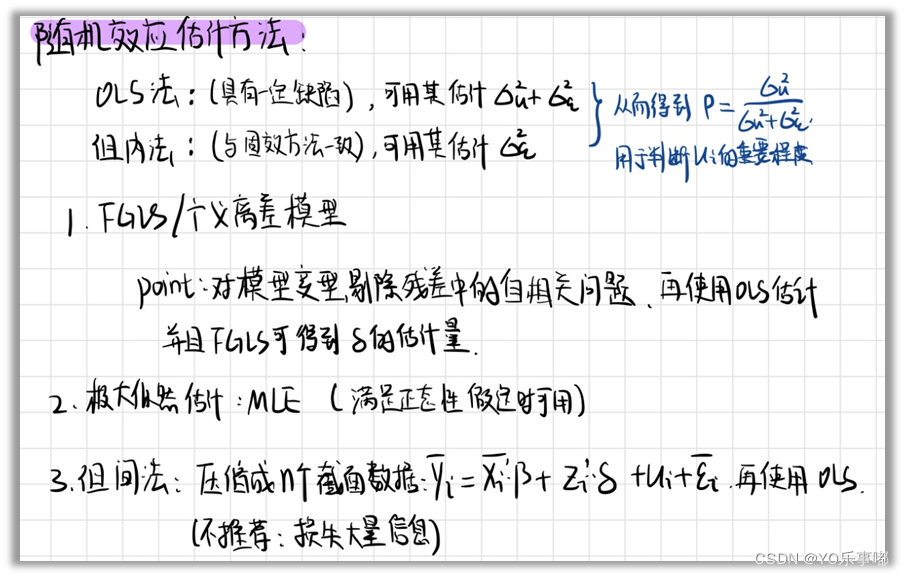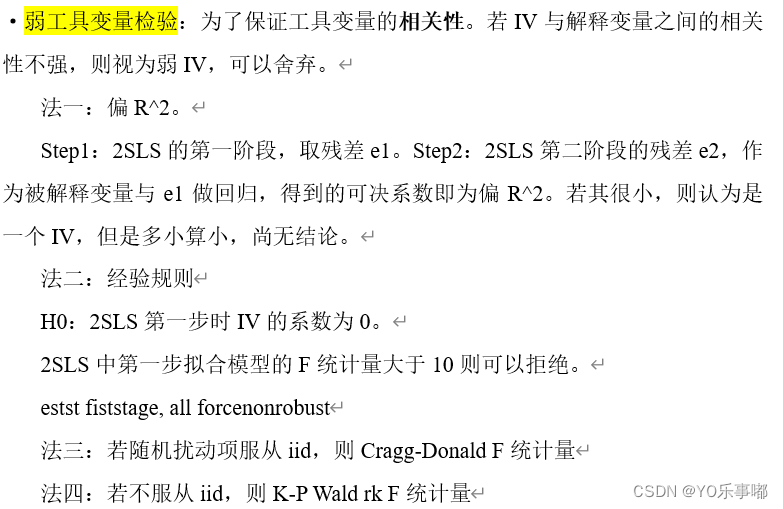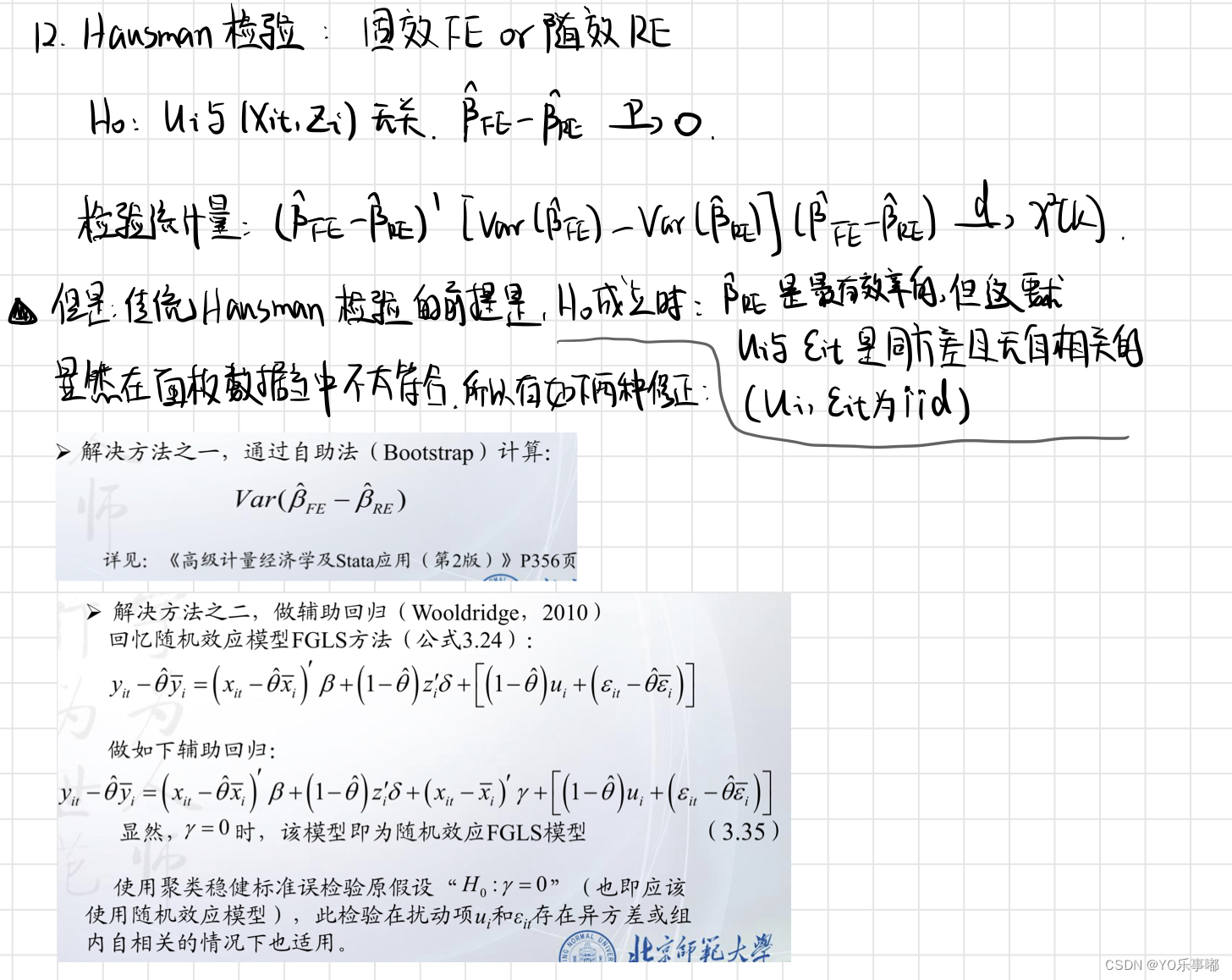目录
以面板数据mus08psidextract.dta为例:

1.导入数据集
stata自带数据集:Stata打开自带的数据合集_9997PZ的博客-CSDN博客_stata数据
外部导入:
. use "F:\个人嘿嘿嘿\北师大BNU\研一上-课业资料\商务与经济统计\作业1\mus08psidextract.dta",clear 2.面板数据有关信息
面板数据是一种多维数据,一般具有两个维度:个体(组、类)和时间。
面板数据既含有n个个体截面的数据,也含有长为T的时间序列。
2.1设定面板数据的个体变量和时间变量
. xtset id t //id:个体变量 t:时间变量 顺序不可以变
Panel variable: id (strongly balanced)
Time variable: t, 1 to 7
Delta: 1 unit
2.2显示面板数据的结构:
. xtdes
2.3显示数据集中变量的统计特征:
. xtsum
. xtsum lwage ed exp exp2 wks id t
Variable | Mean Std. dev. Min Max | Observations
-----------------+--------------------------------------------+----------------
lwage overall | 6.676346 .4615122 4.60517 8.537 | N = 4165
between | .3942387 5.3364 7.813596 | n = 595
within | .2404023 4.781808 8.621092 | T = 7
| |
ed overall | 12.84538 2.787995 4 17 | N = 4165
between | 2.790006 4 17 | n = 595
within | 0 12.84538 12.84538 | T = 7
| |
exp overall | 19.85378 10.96637 1 51 | N = 4165
between | 10.79018 4 48 | n = 595
within | 2.00024 16.85378 22.85378 | T = 7
| |
exp2 overall | 514.405 496.9962 1 2601 | N = 4165
between | 489.0495 20 2308 | n = 595
within | 90.44581 231.405 807.405 | T = 7
| |
wks overall | 46.81152 5.129098 5 52 | N = 4165
between | 3.284016 31.57143 51.57143 | n = 595
within | 3.941881 12.2401 63.66867 | T = 7
| |
id overall | 298 171.7821 1 595 | N = 4165
between | 171.906 1 595 | n = 595
within | 0 298 298 | T = 7
| |
t overall | 4 2.00024 1 7 | N = 4165
between | 0 4 4 | n = 595
within | 2.00024 1 7 | T = 7
.
std.dev:基于样本估算标准偏差,反映数值相对于平均值的离散程度;
可以看出id的组内离散程度为0(同一个体内,个体无变化),t的组间离散程度为0(同一时间,每一个个体之间时间无差别);ed可以看作,是可以观测到的个体异质性;
3.混合回归
. reg y x1 x2 x3…,vce(cluster id)
其中vce(cluster id)【聚类标准误】可替换为:robust / r【稳健标准误】 or 什么都不加【普通标准误】,下面各种模型回归同理。
注:_cons为默认加入的常数项,如果要求不含常数项则使用:reg y x1 x2 x3…,nocons
reg lwage exp exp2 wks ed,vce(cluster id) //使用聚类稳健标准误
Linear regression Number of obs = 4,165
F(4, 594) = 72.58
Prob > F = 0.0000
R-squared = 0.2836
Root MSE = .39082
(Std. err. adjusted for 595 clusters in id)
------------------------------------------------------------------------------
| Robust
lwage | Coefficient std. err. t P>|t| [95% conf. interval]
-------------+----------------------------------------------------------------
exp | .044675 .0054385 8.21 0.000 .0339941 .055356
exp2 | -.0007156 .0001285 -5.57 0.000 -.0009679 -.0004633
wks | .005827 .0019284 3.02 0.003 .0020396 .0096144
ed | .0760407 .0052122 14.59 0.000 .0658042 .0862772
_cons | 4.907961 .1399887 35.06 0.000 4.633028 5.182894
------------------------------------------------------------------------------
4.随机效应模型
4.1随机效应模型or混合回归模型的选择:LM检验
LM检验 检验是否存在个体效应 从而确定使用
(使用FGLS法会提供一个theta值,从而完成LM检验)
4.2随机效应模型:两种估计方法

A.FGLS法:广义离差模型
. xtreg y x1 x2…, re r theta
. xtreg lwage exp exp2 wks ed, re r theta
Random-effects GLS regression Number of obs = 4,165
Group variable: id Number of groups = 595
R-squared: Obs per group:
Within = 0.6340 min = 7
Between = 0.1716 avg = 7.0
Overall = 0.1830 max = 7
Wald chi2(4) = 1598.50
corr(u_i, X) = 0 (assumed) Prob > chi2 = 0.0000
theta = .82280511
(Std. err. adjusted for 595 clusters in id)
------------------------------------------------------------------------------
| Robust
lwage | Coefficient std. err. z P>|z| [95% conf. interval]
-------------+----------------------------------------------------------------
exp | .0888609 .0039992 22.22 0.000 .0810227 .0966992
exp2 | -.0007726 .0000896 -8.62 0.000 -.0009481 -.000597
wks | .0009658 .0009259 1.04 0.297 -.000849 .0027806
ed | .1117099 .0083954 13.31 0.000 .0952552 .1281647
_cons | 3.829366 .1333931 28.71 0.000 3.567921 4.090812
-------------+----------------------------------------------------------------
sigma_u | .31951859
sigma_e | .15220316
rho | .81505521 (fraction of variance due to u_i)
------------------------------------------------------------------------------
可以看到theta=0.8228,LM检验中:强烈拒绝“不存在个体随机效应”的原假设,个体效应存在,在混合回归和随机效应模型当中应该选择随机效应模型;
rho=0.8151 进一步证明ui部分在方程中起到重要的作用,是不可以被忽略的;
B.MLE法:极大似然估计
当扰动项服从正态分布时,可以使用此方法。
. xtreg y x1 x2 x3…,mle
4.3双向随机效应模型
FGLS(估计个体效应)+LSDV法(估计时间效应)估计
. xtreg y x1 x2 x3…i.year,re
5.固定效应模型
5.1固定效应模型or混合回归之间的选择:
H0:all ui=0
普通标准误的估计时会给出一个F检验结果:F=53.12 p=0.000 则拒绝原假设,即应当使用固定效应模型
5.2固定效应模型估计方法
A.组内法:FE
. xtreg y x1 x2…, fe
缺点:无法估计出可观测的个体异质性的系数
,所以下表中ed 为omitted状态
注意:xtreg下r(robust)等价于聚类稳健标准误
. xtreg lwage exp exp2 wks ed, fe //普通标准误
note: ed omitted because of collinearity.
Fixed-effects (within) regression Number of obs = 4,165
Group variable: id Number of groups = 595
R-squared: Obs per group:
Within = 0.6566 min = 7
Between = 0.0276 avg = 7.0
Overall = 0.0476 max = 7
F(3,3567) = 2273.74
corr(u_i, Xb) = -0.9107 Prob > F = 0.0000
------------------------------------------------------------------------------
lwage | Coefficient Std. err. t P>|t| [95% conf. interval]
-------------+----------------------------------------------------------------
exp | .1137879 .0024689 46.09 0.000 .1089473 .1186284
exp2 | -.0004244 .0000546 -7.77 0.000 -.0005315 -.0003173
wks | .0008359 .0005997 1.39 0.163 -.0003399 .0020116
ed | 0 (omitted)
_cons | 4.596396 .0389061 118.14 0.000 4.520116 4.672677
-------------+----------------------------------------------------------------
sigma_u | 1.0362039
sigma_e | .15220316
rho | .97888036 (fraction of variance due to u_i)
------------------------------------------------------------------------------
F test that all u_i=0: F(594, 3567) = 53.12 Prob > F = 0.0000
. xtreg lwage exp exp2 wks ed, fe vce(cluster id) //聚类稳健标准误
note: ed omitted because of collinearity.
Fixed-effects (within) regression Number of obs = 4,165
Group variable: id Number of groups = 595
R-squared: Obs per group:
Within = 0.6566 min = 7
Between = 0.0276 avg = 7.0
Overall = 0.0476 max = 7
F(3,594) = 1059.72
corr(u_i, Xb) = -0.9107 Prob > F = 0.0000
(Std. err. adjusted for 595 clusters in id)
------------------------------------------------------------------------------
| Robust
lwage | Coefficient std. err. t P>|t| [95% conf. interval]
-------------+----------------------------------------------------------------
exp | .1137879 .0040289 28.24 0.000 .1058753 .1217004
exp2 | -.0004244 .0000822 -5.16 0.000 -.0005858 -.0002629
wks | .0008359 .0008697 0.96 0.337 -.0008721 .0025439
ed | 0 (omitted)
_cons | 4.596396 .0600887 76.49 0.000 4.478384 4.714408
-------------+----------------------------------------------------------------
sigma_u | 1.0362039
sigma_e | .15220316
rho | .97888036 (fraction of variance due to u_i)
------------------------------------------------------------------------------
B.LSDV法
. reg y x1 x2 x3…i.id,vce(cluster id)
i.id:表示根据变量id而产生的虚拟变量,生成n个虚拟变量(or 有截距项时生成n-1个)
优点:可以求出可观测的个体异质性的系数
C.一阶差分法FD
无专门命令,可以使用一些其他方法来附带进行(?待补充)
5.3.双向固定效应模型LSDV法
法一:. xtreg y x1 x2…i.year, fe r
法二:. reg lwage exp exp2 wks ed i.id i.year, robust
若数据未变形:(如把1976-1982转为1-7)
. tab year,gen(year)
若数据已经为标准形式,则直接使用
. xtreg lwage exp exp2 wks ed i.t, fe r
note: ed omitted because of collinearity.
note: 7.t omitted because of collinearity.
Fixed-effects (within) regression Number of obs = 4,165
Group variable: id Number of groups = 595
R-squared: Obs per group:
Within = 0.6599 min = 7
Between = 0.0275 avg = 7.0
Overall = 0.0480 max = 7
F(8,594) = 412.33
corr(u_i, Xb) = -0.9089 Prob > F = 0.0000
(Std. err. adjusted for 595 clusters in id)
------------------------------------------------------------------------------
| Robust
lwage | Coefficient std. err. t P>|t| [95% conf. interval]
-------------+----------------------------------------------------------------
exp | .1119927 .0041184 27.19 0.000 .1039043 .1200812
exp2 | -.0004051 .0000834 -4.86 0.000 -.0005688 -.0002413
wks | .00068 .0008812 0.77 0.441 -.0010506 .0024105
ed | 0 (omitted)
|
t |
2 | -.0083984 .0049321 -1.70 0.089 -.0180849 .0012881
3 | .0259652 .0084359 3.08 0.002 .0093974 .0425329
4 | .0289134 .0078093 3.70 0.000 .0135762 .0442506
5 | .0239406 .0065275 3.67 0.000 .0111208 .0367604
6 | .0069955 .0064617 1.08 0.279 -.0056949 .019686
7 | 0 (omitted)
|
_cons | 4.618339 .0599451 77.04 0.000 4.500609 4.736069
-------------+----------------------------------------------------------------
sigma_u | 1.0268811
sigma_e | .15159041
rho | .97867247 (fraction of variance due to u_i)
------------------------------------------------------------------------------
6.豪斯曼检验:固定效应模型or随机效应模型
6.1传统Hausman检验
(前提:ui与eit是独立同分布的)
. xtreg lwage exp exp2 wks ed, fe
. estimates store FE
. xtreg lwage exp exp2 wks ed, re theta
. estimates store RE
. hausman FE RE,constant sigmamore
注:必须使用普通标准误,不可以使用稳健标准误
若原假设成立,则认为ui与xi和eit无相关性,应当使用随机效应模型;
. hausman FE RE,constant sigmamore
---- Coefficients ----
| (b) (B) (b-B) sqrt(diag(V_b-V_B))
| FE RE Difference Std. err.
-------------+----------------------------------------------------------------
exp | .1137879 .0888609 .0249269 .0012778
exp2 | -.0004244 -.0007726 .0003482 .0000285
wks | .0008359 .0009658 -.0001299 .0001108
_cons | 4.596396 3.829366 .7670299 .
------------------------------------------------------------------------------
b = Consistent under H0 and Ha; obtained from xtreg.
B = Inconsistent under Ha, efficient under H0; obtained from xtreg.
Test of H0: Difference in coefficients not systematic
chi2(4) = (b-B)'[(V_b-V_B)^(-1)](b-B)
= 1374.55
Prob > chi2 = 0.0000
(V_b-V_B is not positive definite)
.
由结果来看p值为0.0000则强烈拒绝原假设,应当选择固定个体效应模型;
再对时间效应进行检验(?应当比较时间固定模型还是直接比较双向固定模型
6.2非传统Hausman检验
前提:ui与eit都不再是iid情况下
即当聚类稳健标准误与普通标准误相差较大时,显然不再满去传统Hausman检验的前提,此时要使用另一种方法:
H0:=0
. ssc install xtoverid
. xtreg y x1 x2 …,re r //先运行聚类稳健标准误的RE
. xtoverid
. xtoverid //非传统豪斯曼检验
Test of overidentifying restrictions: fixed vs random effects
Cross-section time-series model: xtreg re robust cluster(id)
Sargan-Hansen statistic 1792.412 Chi-sq(3) P-value = 0.0000-----22.12.8 在期末复习(苦涩)补充一些知识点-----
7.理论知识点补充
7.1一般建模流程(待完善补充)

7.2三种标准误

7.3FE与RE的估计方法总结
7.3.1固定效应模型:组内法、LSDV法、差分法

7.3.2随机效应模型估计方法:广义离差模型FGLS法、极大似然估计
此时OLS估计结果是一致的,但是由于复合扰动项中,有个体效应的存在,所以复合扰动项之间不满足自相关和同方差假设,则OLS回归结果虽然一致但不有效。


7.4工具变量辅助检验
面板数据的内生性问题:
虽然面板数据的个体异质性可以一定程度上缓解遗漏变量问题,但是模型仍然可能存在内生性(测量误差、模型误设、双向因果等)。此时可以使用工具变量法。
7.4.1(固定效应模型)使用IV的步骤:
Step1:对模型变换以缓解遗漏变量的影响,模型组内离差(或一阶差分);
Step2:再使用IV,做2SLS;
7.4.2工具变量四个辅助检验



7.5动态面板数据
动态面板数据PDP:指解释变量中包含被解释变量的滞后项。
是解决内生性问题的最后手段:用于解决遗漏变量以及双向因果导致的内生性。
三种常用估计方法:差分GMM、水平GMM、系统GMM。
